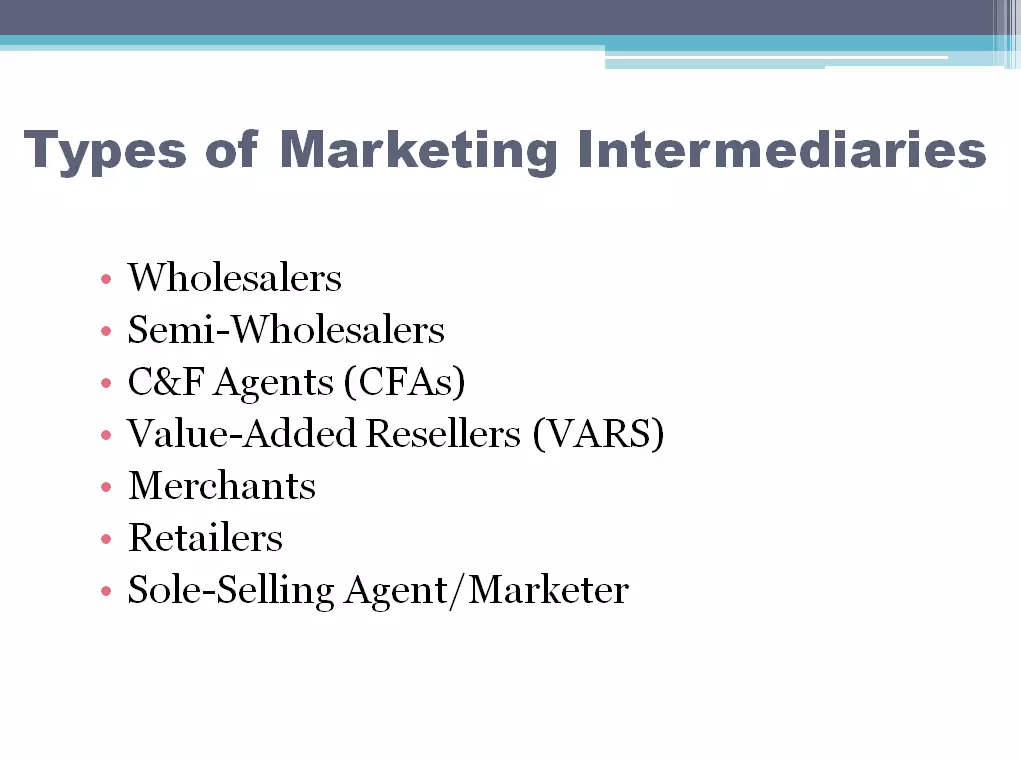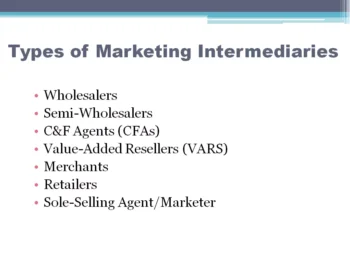Table of Contents:-
- Marketing Intermediaries Meaning
- Types of Marketing Intermediaries
- Need of Marketing Intermediaries
- Marketing intermediaries function
Marketing Intermediaries Meaning
Marketing intermediaries are essential in getting products and services from producers to consumers. They act as a bridge between the two, ensuring that products and information flow seamlessly.
Marketing intermediaries are links in the distribution channel. Their expertise, market know-how, and operational capabilities greatly contribute to the success of producers and customer satisfaction. By adeptly connecting producers and consumers, marketing intermediaries play a crucial role in the growth and profitability of businesses.
Channel members are the middlemen or intermediaries. Intermediaries are essential components within a company’s product Channel of Distribution. Their knowledge, resources, and market insights empower them to effectively connect manufacturers with consumers. By facilitating distribution, cutting costs, and improving communication, intermediaries play a vital role in propelling a company’s growth and success in the marketplace. Either, in the channel there is one middleman like a sole selling agent who distributes the goods through several middlemen subsequently or, there may be several middlemen when the producer distributes the products through several agents or wholesalers or even retailers. Retailers directly sell to consumers, whereas wholesalers sell their products through intermediaries.
Intermediaries are essential for the seamless operation of a business. It would be highly challenging for the business to function effectively without their involvement. This is because intermediaries are external groups, individuals, or businesses that make it possible for the company to deliver their products to the end user. For example, Merchants act as intermediaries who buy goods and then resell them.

Types of Marketing Intermediaries
The types of channel members in indirect distribution channels (apart from the zero level) are as follows:
- Wholesalers
- Semi-Wholesalers
- C&F Agents (CFAs)
- Value-Added Resellers (VARS)
- Merchants
- Retailers
- Sole-Selling Agent/Marketer
1) Wholesalers
A wholesaler, stockist, or distributor plays a substantial role in the market, although their scale, resources, and operational territory may not match that of a marketer or sole selling agent. Wholesalers, stockists, or distributors play a role in the marketer-sole selling agent system used by manufacturers. Wholesalers are quite common in the consumer goods industry.
2) Semi-Wholesalers
Semi-wholesalers are intermediaries who buy products either from producers or wholesalers in bulk, break the bulk or resell the goods (mostly) to retailers in assortments needed by them. Like the wholesalers, semi-wholesalers perform the various wholesaling functions that are part of the distribution process. They might also engage in retail activities at times. Their strength is ‘specialisation by region’.
3) C&F Agents (CFAs)
Anyone engaged in providing services, whether directly or indirectly, is taken into account. concerned with the clearing and forwarding operations in any manner to any other person or includes a consignment agent is C&F agents. Many times, manufacturers enlist the services of carrying and forwarding agents, often referred to as C & F Agents, or CFAs. CFAs represent a specialized group within the wholesale sector.
4) Value-Added Resellers (VARS)
VARS are intermediaries that buy the basic product from producers and add value to it or, depending on the nature of the product, modify it and then resell it to final customers VAR is a company that adds features or services to an existing product and then resells it (usually to end-users) as an integrated product or complete “turn-key solution. In the electronics field, this approach is quite common, especially when Value-Added Resellers (VARs) incorporate software with their hardware.
5) Merchants
Merchants are intermediaries that assume ownership of the goods that they sell to customers or other intermediaries. Merchants usually take physical possession of the goods they sell, serving as intermediaries who take ownership of these items before selling them to customers or other intermediaries. This approach enables merchants to efficiently facilitate the exchange of goods in the market. Merchants usually take physical possession of the goods that they sell. Merchants are those channel participants who have specific tasks that they must perform.
6) Retailers
Retailers sell to the household/ultimate consumers. They are at the bottom of the distribution hierarchy, working under wholesalers/stockists/distributors/semi-wholesalers, as the case may be. In cases where the company operates a single-tier distribution system, they operate directly under the company. They operate in a relatively smaller territory or at a specific location; they do not normally perform stock-holding and sub-distribution functions. The stocks they keep are operational stocks necessary for immediate sale at the retail outlet.
7) Sole-Selling Agent/Marketer
When a manufacturer prefers to stay out of the marketing and distribution task, he appoints a suitable agency as his sole selling agent/marketer and entrusts the marketing job to him. A sole-selling agent, often referred to as a marketer, is typically a major marketing intermediary with important resources and an extensive operational reach.

Related Articles:
- nature of marketing
- difference between questionnaire and schedule
- features of marginal costing
- placement in hrm
- limitations of marginal costing
- nature of leadership
- difference between advertising and personal selling
Need of Marketing Intermediaries
1) To ensure the product is readily available to the target market consumers
Perhaps the most important factor here is to ensure that the product is represented in the right type of outlet or retail store. The company’s success in the marketplace greatly depends on selecting the right physical distribution channel. By carefully assessing market trends, understanding customer preferences, and meeting logistical needs, the company can fine-tune its distribution strategy and successfully reach its target audience.
2) To increase the probability of sales occurring
This can be achieved in several ways. The choice of the channel depends on the product and the type of retail store, with key factors in mind. The primary goals are to secure prime store placement, attractive displays, and, when necessary, the enthusiastic support of retail salespeople. It’s important to showcase the product prominently, make it easy for customers to access it, and present it enticingly. Channel choice is affected by this objective in several ways:
i) Are special displays used?
ii) Does the product need to be installed, demonstrated or explained?
iii) Is there a special promotion for the product?
iv) Does the deliverer arrange the merchandise in the shop?
3) To Achieve Cooperation about any Relevant Distribution Factors
These factors may be from the supplier’s or the receiver’s point of view and include minimum order sizes, unit load types, product handling characteristics, materials handling aids, delivery access (e.g., vehicle size), delivery time constraints, etc.
4) To Achieve a Level of Service
It is important to consistently define, assess, and uphold a particular level of service from both the suppliers’ and customers’ viewpoints. Customers consider this aspect highly important, and the performance in meeting service level expectations is often used to assess and compare suppliers, which can significantly affect future purchasing choices.
5) To Minimise Logistics and Total Costs
Costs are very important, as they are reflected in the final price of the product. When selecting a distribution channel, it’s essential to take into account the costs linked to it. These costs should be assessed considering the type of product you’re selling and the level of service you need.
6) To Receive Fast and Accurate Feedback of Information
A smooth and consistent exchange of important information is vital for the efficient operation and maintenance of a distribution service. This includes things like sales trends, inventory levels, reports of damage, service quality, and cost tracking, among other factors.
Marketing intermediaries function
Marketing intermediaries have several important functions:
1. Promotion and Selling: They help promote and sell products by using various marketing techniques to raise awareness and create demand for the goods or services they represent. Their expertise and networks enable them to reach a broader audience and boost sales.
2. Market Insights: Intermediaries offer valuable market insights to producers. They gather information about market trends, customer preferences, and competitor activities through interactions with consumers and retailers. This data helps producers make informed decisions about product development, pricing strategies, and promotional campaigns.
3. Physical Distribution: Intermediaries play a key role in the physical distribution of products. They manage logistics and transportation, ensuring timely delivery to retailers or end consumers. This efficient supply chain management minimizes costs and enhances customer satisfaction.
4. Customer Support: Additionally, marketing intermediaries often provide after-sales support and customer service. They serve as a point of contact for consumers, addressing their inquiries, resolving issues, and offering assistance. This personalized approach strengthens customer relationships and fosters brand loyalty.
